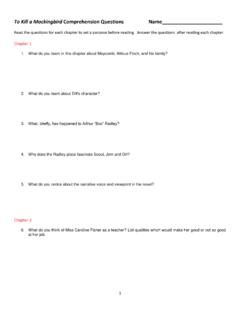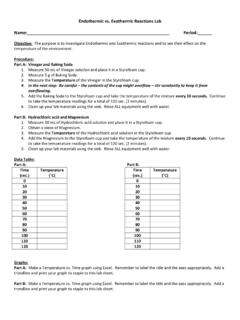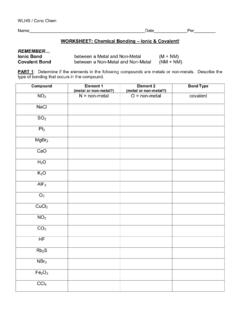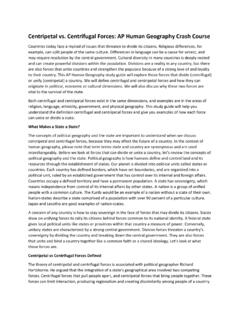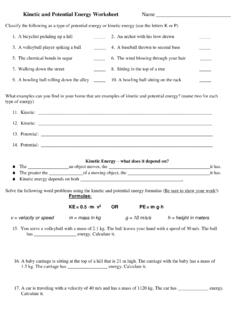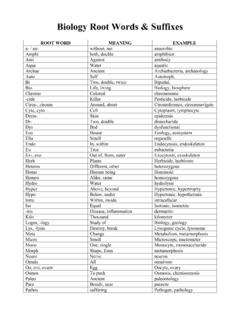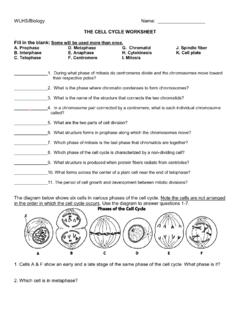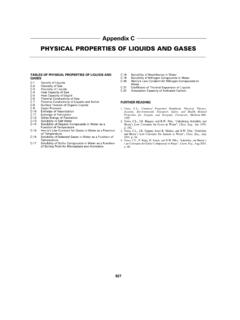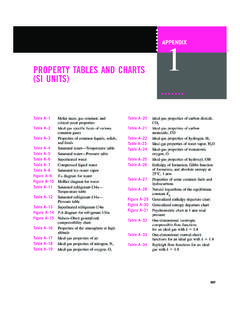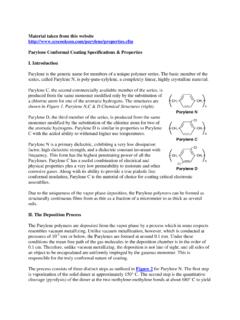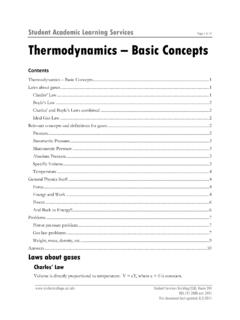Transcription of CHAPTER 6 NOTES: The Periodic Table
1 CHAPTER 6 NOTES: The Periodic TableNOTES: Periodic Table Organizing the ElementsPERIODIC Table : Dmitri Mendeleev mid 1800 s-proposed a Table for 70 elements based on increasing mass and similar properties Henry Moseley 1913-determined the atomic number of elements and arranged the Table in order of increasing atomic numberPeriodic Table Periodicity:( Periodic LAW ) -regular variations (or patterns) of propertieswith increasing atomic weight; both chemical and physical properties vary in a Periodic way (repeating pattern).
2 Group:vertical column of elements( family ) Period:horizontal row of elementsPeriodic Groups and TrendsGroupings to know on the Periodic Table Representative Elements: Group A elements; columns 1A-8A; they include:-metals-nonmetals-metalloidsMETA LS:Characteristics: high electrical conductivity high luster ductile & malleable on the left side of the Periodic Table (except hydrogen)NONMETALS:Characteristics: in the upper-right corner of the Periodic Table nonlustrous poor conductors of electricity some (O, Cl) are gases at room temp.
3 Others (S) are brittle solidsMETALLOIDS:Characteristics: on the stair-step linethat divides the metals from the nonmetals exhibit properties that are intermediate between those of metals and nonmetals important metalloids: silicon, germaniumPERIODIC GROUPS alkali metals alkaline earth metals transition metals lanthanides actinides halogens noble gases inner transition metalsTHE METALS!!Alkali Metals Group 1on Periodic Table Very reactive Soft solids Readily combine with halogens Tendency to lose one electron examples: sodium, potassium, cesiumAlkaline Earth Metals Group 2on Periodic Table Abundant metals in the earth Not as reactive as alkali metals examples: magnesium, strontiumTransition Metals Groups 3 -12on Periodic Table Important for living organisms( as minerals) examples: iron, zinc, manganeseInner Transition Metals!
4 !Lanthanides Part of the inner transition metals Soft silvery metals elements # 57 -70 examples: cerium, europium, ytterbiumActinides Radioactive elements Part of the inner transition metals elements # 89 102 examples: uranium, plutonium, berkeliumTHE NONMETALS!!Halogens Group 17on Periodic Table Salt former combines with groups 1 and 2 to form salts (ionic bonds) examples: fluorine, bromine, iodineNoble Gases Group 18on Periodic Table Relatively inert, or nonreactive Gases at room temperature examples: helium, argon, radonActivity:use a black and white copy of the Periodic one side, color and label the metals, nonmetals, and name for metalloid is semi-metal.
5 Transition metalsalkali metalsalkaline earth metalshalogensnoble gaseslanthanidesactinidesColor and label the groups/families of elements on the other side of your paper. Remember to create a properties & Families Chemical properties of elements are based on their VALENCE ELECTRONS Families are groups of elements that have similar VALENCE ELECTRONS VALENCE ELECTRONS = outermost electrons in an atomVALENCE ELECTRONS:VALENCE ELECTRONS:NOTES: Periodic TrendsPERIODIC Periodicity:regular variations(or patterns) of properties with increasing atomic weight; both chemical and physical properties vary in a Periodic (repeating pattern).
6 Group:vertical column of elements( family ) Period:horizontal row of elementsPERIODIC properties : Atomic radius Ionization energy Ionic size / radius ElectronegativityATOMIC RADIUS: GROUP TREND: increases as you move down a group WHY???-electrons are added to higher energy levels(farther away from the nucleus).ATOMIC RADIUS: Periodic TREND: decreases as you move L to R across a period WHY???-As the # of protons in the nucleus increases, the positive charge increasesand as a result, the pull on the electrons : ION: an atom or group or atoms that has a positive or negative charge atomis electrically neutral because it has equal # of protons (+) & # of electrons (-) positive & negative ions form whenelectrons are transferred between atoms!
7 IONS: atoms of METALS tend to form positive ionsby losing 1 or more e-from their valence (outermost) shell an ion with a positive charge is called a CATION. example: SODIUM (Na Na+)IONS: atoms of NONMETALS tend to form negative ionsby gaining 1 or more e-(& thus filling their outermost energy level) an ion with a negative charge is called an ANION. example: CHLORINE (Cl Cl-) ANIONS(negative ions) have full valence shells: they are LARGER than their neutral ATOM. CATIONS(positive ions) have empty valence shells: they are SMALLER than their neutral ATOM.
8 BUT, the size of one ion compared to the next is the same pattern as ATOMIC RADIUS:IONIZATION ENERGY: Definition: energy required to remove outer electrons results in the formation of a positive ion!IONIZATION ENERGY: GROUP TREND: decreases as you move down a group WHY???-Electrons are in higher energy levelsas you move down a group; they are farther away from the positive pull of the nucleus and therefore easier to ENERGY: Periodic TREND: increases as you move from L to R across a period WHY?
9 ??-The increasing charge in the nucleusas you move across a period exerts greater pull on the electrons; it requires more energy to remove an : Definition: the tendency of an atom to attract electrons of another atomELECTRONEGATIVITY: GROUP TREND: decreases as you move down a group WHY???-higher energy levels means the electrons are farther away from the nucleus; -greater distance = decreased attractionELECTRONEGATIVITY: Periodic TREND: increases as you move across a period(noble gases excluded!)
10 WHY???-nuclear charge is increasing;-atomic radius is decreasingELECTRONEGATIVITY: Most electronegative element: FLUORINE ( ) Least electronegative element: CESIUM ( )**see Table on page 181 for all values!Summing Up Periodic Trends
